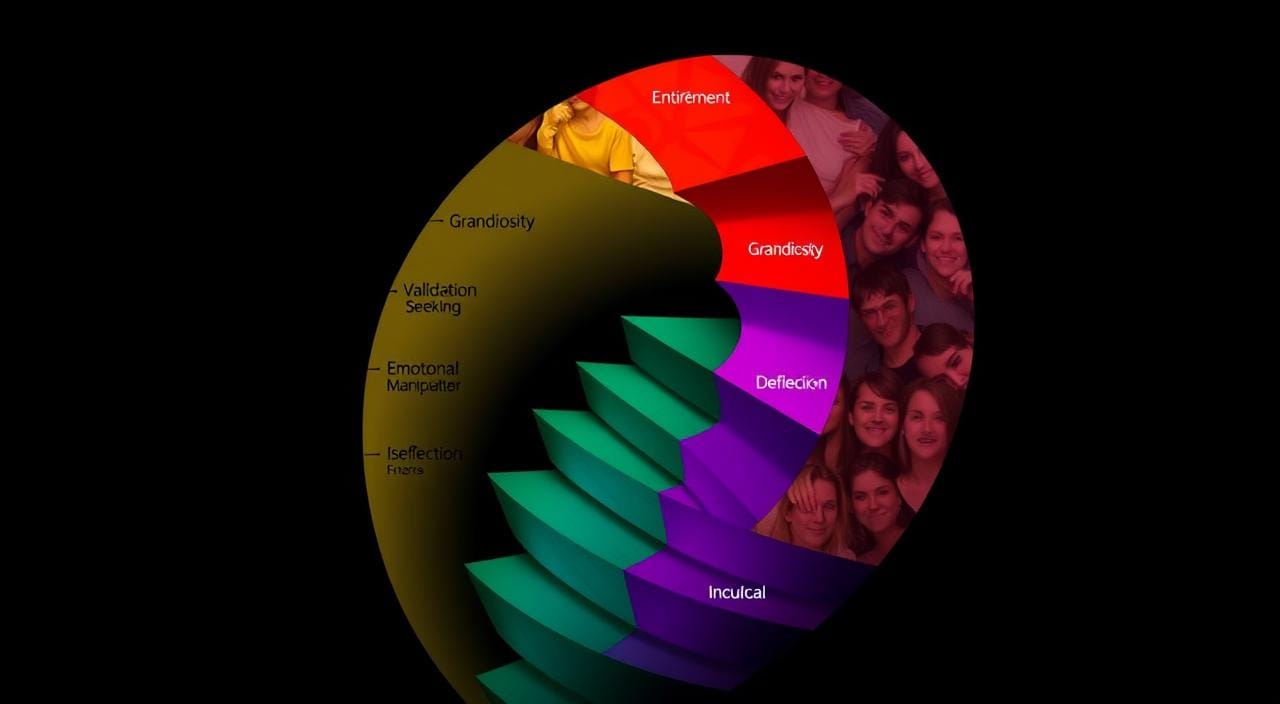Ever questioned your own thoughts, feelings, or what happened to you? If yes, you might be dealing with self-gaslighting. This can come from past emotional or psychological abuse1. It’s a common issue that can make you doubt yourself, feel bad about yourself, and even lead to anxiety or depression1. Lear how to stop gaslighting yourself.
Life’s challenges can make us doubt ourselves sometimes. But if this doubt doesn’t go away, it’s time to look closer. Healing from past traumas and dealing with what makes you doubt yourself is key. It helps you regain your strength and trust in yourself.
Key Takeaways:
- Self-gaslighting is a common defense mechanism stemming from emotional or psychological abuse.
- It can lead to a host of negative impacts, including self-doubt, low self-esteem, anxiety, and depression.
- Addressing the underlying trauma and practicing strategies like reframing thoughts and self-compassion can help combat self-gaslighting.
- Seeking support from loved ones is crucial in breaking free from self-doubt.
- Healing from self-gaslighting takes time and effort, but is possible with the right tools and mindset.
What is Self-Gaslighting?
Gaslighting is when someone makes another person doubt their own thoughts and feelings. It’s become more well-known lately2. Self-gaslighting happens when you start doubting yourself because of these tactics3.
Understanding the Origins of Gaslighting
The term “gaslighting” comes from a 1930s film. In it, a man tricks his wife into doubting her own sanity. This kind of emotional abuse can happen in many relationships, like with narcissists or in bad romantic relationships.
Self-Gaslighting: Internalizing Abuse and Self-Doubt
Self-gaslighting is when you start doubting yourself because of past abuse. It makes you blame yourself or feel ashamed. This can make you lose confidence and always question yourself23.
There are many reasons for self-gaslighting. It can be because of past abuse, growing up in a place that doesn’t talk about feelings, or having mental health issues like depression or anxiety2. Not understanding mental health can also play a part2.
Self-gaslighting is a way to protect yourself from past harm. It makes you doubt your feelings and experiences. But, it’s important to face this and work on healing23.
Examples of Self-Gaslighting Behaviors
Self-gaslighting can show up in many ways. People often doubt their own experiences and feelings4. This emotional abuse makes them question their reality4. It can start in childhood and last into adulthood, causing emotional problems and shame4.
For example, someone might tell themselves a sexual assault wasn’t really assault4. Others might blame themselves for verbal abuse or think their trauma wasn’t that bad4. This self-doubt and shame can make sharing painful experiences even harder4.
Children who experience “invisible bruises” might make up stories to share their pain4. The author once tried to talk about abuse during a sleepover but got mixed reactions4. It’s important to understand where self-gaslighting comes from and to be kind to ourselves4.
| Self-Gaslighting Behaviors | Impacts |
|---|---|
| – Convincing oneself that an experience of sexual assault was not truly sexual assault – Blaming oneself for ongoing verbal abuse from a family member – Telling oneself that traumatic experiences were not “that bad” – Creating stories to externalize childhood pain, only to eventually internalize it | – Emotional dysregulation – Anxiety – Depression – Confusion – Shame |
Self-gaslighting is when people blame themselves for past abuse5. It can come from trauma and make people doubt themselves5. But, being kind to ourselves and understanding our feelings can help5.
Changing negative thoughts to positive ones and trusting ourselves are important steps5. If self-gaslighting is a big problem, getting help from a professional is a good idea5. They can offer support and help deal with the underlying issues5.
Self-gaslighting is common in people who doubt themselves a lot6. It can come from conflicting thoughts and feelings6. Recognizing these patterns is the first step to change6. Building self-confidence and seeking therapy can help those struggling with self-gaslighting6.
“Self-gaslighting perpetuates a cycle where attempts to share traumatic experiences become opportunities for self-doubt and internal criticism.”
Prevalence of Self-Gaslighting
Self-gaslighting isn’t a formal diagnosis, but it’s common. It’s linked to adverse childhood experiences (ACEs). The7 Centers for Disease Control and Prevention (CDC) say over half of adults in the US have had at least one ACE.
Some groups face more self-gaslighting due to being more vulnerable to external abuse. Studies show7 74% of women in abusive relationships experience gaslighting. Also7, 5% of Americans have Narcissistic Personality Disorder (NPD), up from 0.5% in 2005. A 2011 study found 6.2% of the population had NPD, showing gaslighting behaviors are on the rise.
Gaslighting isn’t just in personal relationships7. It’s also common online, with many resources available. This increased awareness helps us understand self-gaslighting better, especially for marginalized groups.
Populations More Susceptible to Self-Gaslighting
Some identities face specific types of gaslighting, like racist gaslighting or gaslighting of transgender children8. Empaths, who feel others’ emotions deeply, are especially at risk. They often doubt their own feelings and experiences.
8 Past trauma can deeply affect empaths as adults, leading to self-gaslighting. Using tools like artificial intelligence (AI) can help empaths understand their emotions better. This empowers them to trust their feelings and stop self-gaslighting.
“Empaths often gaslight themselves, doubting their feelings due to past experiences.”
The Connection Between Self-Gaslighting and Trauma
Self-gaslighting is when you doubt your own experiences. It often comes from trauma, like sexual assault or losing someone close. It’s a way to avoid discomfort or danger by doubting yourself9.
Self-Gaslighting as a Trauma Response
People with PTSD or who have been through trauma might doubt themselves more. They might blame themselves instead of facing the trauma10. This can make them lose confidence and question themselves a lot11.
Childhood trauma can also make people doubt themselves more. They might not trust their own thoughts or memories10.
Societal norms and gender stereotypes can make self-doubt worse, especially for certain groups10. Feeling like you don’t meet expectations can make you doubt yourself even more10.

It’s important to understand how trauma and self-gaslighting are connected. Knowing this can help people stop doubting themselves and find their true selves10.
Impacts of Self-Gaslighting on Mental Health
Self-gaslighting can severely harm your mental health. It involves doubting your own reality and worth. Studies link it to higher anxiety, depression, and lower self-esteem12.
Causes include fear of failure, negative self-image, and too much anxiety12. People who have faced gaslighting or toxic relationships are more likely to doubt themselves12.
Self-gaslighting can make you question your decisions and memories. It can also make you blame yourself for others’ actions12. This can lead to staying in bad relationships and low self-esteem12.
The effects of self-gaslighting are serious. They can lead to mental health issues, relationship problems, and even substance abuse12. It can happen in work, family, or personal relationships13.
Gaslighting tries to control your perception. It makes you doubt your own thoughts and feelings13. This can make you believe you’re not good enough or that there’s something wrong with you13.
Breaking free from self-gaslighting is key. You must reject negative thoughts, hold the gaslighter accountable, and start rebuilding your self-esteem13. Surround yourself with positive people, practice self-compassion, and seek help when needed12.
Therapeutic Approaches for Addressing Self-Gaslighting
Seeking professional help is key to overcoming self-gaslighting. Two effective therapies are Trauma-Focused Cognitive Behavioral Therapy (TF-CBT) and Eye Movement Desensitization and Reprocessing (EMDR).
Trauma-Focused Cognitive Behavioral Therapy
Trauma-Focused Cognitive Behavioral Therapy (TF-CBT) is very helpful for those dealing with self-gaslighting. It helps clients see how their trauma affects their thoughts, feelings, and actions. They learn new ways to cope with trauma14.
TF-CBT tackles the root of self-doubt and self-criticism. It empowers people to stop self-gaslighting.
Eye Movement Desensitization and Reprocessing Therapy
Eye Movement Desensitization and Reprocessing (EMDR) therapy is also effective. It uses eye movements or other bilateral stimulation to process traumatic memories14. This reduces the emotional impact of these memories.
By focusing on the trauma, EMDR helps individuals overcome self-doubt and negative self-talk. These are common causes of self-gaslighting.
| Therapeutic Approach | Key Benefits |
|---|---|
| Trauma-Focused Cognitive Behavioral Therapy (TF-CBT) |
|
| Eye Movement Desensitization and Reprocessing (EMDR) Therapy |
|
Seeking professional help and using these therapies can help individuals overcome self-gaslighting. They can regain their self-worth and experience life more authentically14.
“Healing is a journey, not a destination. With the right support and therapeutic tools, individuals can overcome the self-doubt and negative self-talk that perpetuate self-gaslighting.”
How to Stop Gaslighting Yourself
Stopping self-gaslighting starts with knowing yourself and being kind to yourself9. Treat yourself with the same care you would give a friend9. Write down your real thoughts and feelings in a journal. Then, speak them out loud to yourself in the mirror9.
This helps affirm your experiences and fight off self-doubt from self-gaslighting.
Embrace Self-Compassion
Self-gaslighting is when you deceive yourself instead of facing the truth9. It can make you downplay your feelings or change your memories9. It’s about making unhealthy comparisons and blaming yourself too much9.
To stop this, be kind to yourself like you would to a friend9. This change helps you accept yourself more.
Anchor in Your Truth
Self-gaslighting acts as a defense to avoid change and keep mental peace9. By staying true to yourself, you can overcome these defenses9. Writing in a journal and speaking your truth can affirm your experiences9.
This self-reflection is key to breaking free from self-deception.
People with low self-esteem or past traumas are more likely to self-gaslight9. Cultural and social pressures can also lead to self-deception9. Honest self-talk and staying true to yourself are essential to overcome these challenges.
Self-gaslighting happens when you minimize your feelings or doubt your experiences15. Signs include constant doubt, feeling guilty for your emotions, and rationalizing them away15. Recognizing and naming this pattern without shame is the first step15.
Getting curious about your feelings with compassion is a big step in stopping self-gaslighting15.
Being aware of your thoughts and feelings is like “minding your mind”15. Noticing and acknowledging your true feelings can improve your emotional well-being and decision-making15. Inviting God into your emotions and accepting them can bring peace and clarity15.
By aligning with God’s Spirit and accepting your emotions, you can care for yourself and be honest with others15.
To stop self-gaslighting, embrace self-compassion, stay true to yourself, use the “Stop” technique, and trace your thoughts9. Seeking professional help for mindset coaching can also help9. Breaking the cycle requires self-awareness and honest self-talk9.
The “Stop” Technique for Breaking Self-Gaslighting Cycles
Dealing with16 self-gaslighting can be tough. But, there’s a strong tool to help: the “stop” technique. When we start doubting ourselves, saying “stop” can stop those negative thoughts. It brings us back to the present17.
This method helps us17 become more aware of ourselves. It lets us take back control and fight off self-gaslighting. By stopping the negative talk, we can see things more clearly17.
The “stop” technique is a great way to break free from self-gaslighting. It helps us pause, breathe, and focus on the moment. We avoid getting caught up in our own mind’s tricks17.
Adding this technique to our self-care can help us grow. It increases our17 self-awareness and mindfulness. These are key to beating self-gaslighting and finding our true worth17.
Learning the “stop” technique is a big step towards overcoming self-gaslighting. It leads us to a more genuine and kinder way of living.

Remember, the journey to self-acceptance and trust is challenging. But, with the right tools and attitude, we can17 take back our power. The “stop” technique is a key first step on this journey1617.
Trace the Origins of Self-Gaslighting Thoughts
Discovering where our self-gaslighting thoughts come from is key to overcoming them. Looking into our past, family life, and the messages from society helps us understand why we doubt ourselves. This way, we can start to see the real reasons behind our self-criticism.
Thinking back to our childhood can reveal how we started to doubt our own thoughts and feelings. The family we grew up in, the messages about our worth, and how we were treated all shape our self-gaslighting behaviors.18
Also, the societal norms we’ve learned can greatly influence our self-gaslighting thoughts. The need to fit in, the high standards we’re expected to meet, and not being seen as our true selves can lead to deep self-doubt.18
By digging into our past, we can learn a lot about why we doubt ourselves. This journey helps us challenge the negative stories we tell ourselves. It opens the door to a more genuine and kinder way of living.
Tracing the roots of our self-gaslighting thoughts is a powerful step towards finding ourselves again. By exploring these roots, we can find the causes of our struggles. This leads us to healing and accepting ourselves for who we are.
Seek Professional Help for Persistent Self-Gaslighting
If you find yourself stuck in self-gaslighting, it’s time to get help. A therapist or counselor who knows about trauma can be a big help. They can teach you how to deal with your feelings and build self-confidence19.
People who are scared of shame and embarrassment often feel stressed and doubt themselves19. Past hurts or criticism can make you see yourself in a bad light19. Feeling like an imposter can make it hard to stop self-gaslighting19. Therapy is a safe place to work on these feelings19. Learning to be kind to yourself can help you see yourself more clearly19.
| Factors Contributing to Self-Gaslighting | Therapeutic Approaches |
|---|---|
|
|

Getting help can help you stop self-gaslighting and find your self-worth again19. A good therapist or counselor can give you the tools to beat self-gaslighting19. This way, you can live a life that’s true to you19.
“Therapy provides a structured and supportive environment for exploring negative self-worth and cultivating self-compassion – both essential for breaking the cycle of self-gaslighting.”
Redirect and Rebrand Self-Gaslighting Thoughts
After finding where your self-gaslighting thoughts come from, it’s time to change them. Try seeing things from other, more realistic views22. Think about what a trusted friend or loved one might say in the same situation. Or find a middle ground between “I’m perfect” and “I’m a complete failure.”22
It’s also key to stop negative self-talk and replace it with kinder thoughts. This can weaken self-gaslighting over time23. Knowing about gaslighting can also help you have healthier relationships in the future22.
See Other Points of View
When you’re caught in self-gaslighting, step back and look at things differently. Imagine how a close friend or family member sees the same situation. Often, we’re our own worst critics, but others can offer a more balanced view22.
Turn Away from Negative Thoughts
It’s important to stop negative self-talk to break the self-gaslighting cycle23. When you notice negative thoughts, switch to more positive, kind ones23. Changing these thoughts can help you see yourself and your abilities more realistically22.

Remember, changing self-gaslighting thoughts, cognitive reappraisal, and mindfulness are strong tools to regain your self-worth22. By changing your inner dialogue, you can become more empowered and true to yourself23.
Conclusion
In conclusion, self-gaslighting is harmful and affects our mental health. Understanding its origins and how to stop it is key. We can overcome self-doubt and criticism with self-compassion and professional help24.
Reclaiming our truth and silencing the inner critic is vital. It leads to a happier, more fulfilling life.
Self-gaslighting is complex and can come from trauma, abuse, and mental health issues25. Recognizing its prevalence helps us understand the need for support and intervention.
The main points are: self-gaslighting harms our mental health, knowing its causes is important, and using self-compassion and professional help helps us overcome it2425. With the right support, we can live a more authentic and fulfilling life.
FAQ
What is self-gaslighting?
Self-gaslighting happens when you start doubting your own thoughts, memories, and feelings. It’s a way to avoid dealing with hard experiences. It’s like doubting your own sanity.
What are some examples of self-gaslighting behaviors?
Self-gaslighting can make you think an assault wasn’t real or that you’re to blame for abuse. It’s also doubting your trauma or feeling too sensitive. These are ways to avoid facing the truth.
How common is self-gaslighting?
Self-gaslighting isn’t officially recognized, but it’s linked to childhood trauma. The CDC says over half of U.S. adults have had a tough childhood. This makes them more likely to doubt themselves.
What is the connection between self-gaslighting and trauma?
Self-gaslighting often comes from trauma. It’s a way to protect yourself from pain or danger. People who have been through trauma, like PTSD or sexual assault, might doubt themselves more.
How does self-gaslighting impact mental health?
Self-gaslighting can lead to serious mental health issues. It can cause extreme doubt, anxiety, depression, and addiction. It can also make you feel really bad about yourself, leading to depression or even suicidal thoughts.
What therapeutic approaches can help address self-gaslighting?
Two helpful therapies are Trauma-Focused Cognitive Behavioral Therapy (TF-CBT) and Eye Movement Desensitization and Reprocessing (EMDR). They help you understand your trauma and find better ways to cope. They also reduce the trauma’s effects.
How can I stop gaslighting myself?
First, figure out why you doubt yourself. Then, change your thoughts by seeing things more clearly. Replace negative thoughts with kinder ones. This helps you stop doubting yourself.
Source Links
- How To Stop Gaslighting Yourself: Actionable Steps to Help You Break Free
- Can you gaslight yourself? A therapist’s take
- What Is ‘Self-Gaslighting’ and How Do I Unlearn It?
- What Is Self-Gaslighting?
- Understanding Self-Gaslighting and How to Overcome it
- How People Can Gaslight Themselves
- Gaslighting: What Is It And How Do We Fight Back?: Middle Georgia State University
- Why Empaths Gaslight Themselves and How to Stop
- How to Stop Gaslighting Yourself: Self-Deception vs Self Truth
- How You Are Gaslighting Yourself — Anchor Therapy, LLC
- What Is Self-Gaslighting? Signs and How to Stop
- Are You Gaslighting Yourself? Here’s How to Tell.
- Self-Gaslighting: The Harm of Being Gaslighted
- Self-Gaslighting & CBT — My CBT
- It’s Time to Stop Gaslighting Yourself – Propel Women
- What is Gaslighting? 20 Techniques to Stop Emotional Abuse
- How to Break the Vicious Self-Gaslighting Habit
- Stop gaslighting yourself!! 4 ways to stop self-gaslighting
- A Psychologist Helps You Grasp And Conquer ‘Self-Gaslighting’
- Stop Gaslighting Yourself. It’s Time to Believe Your Own Truth – Soar with Mary
- Council Post: Are You Gaslighting Yourself?
- I Was a Victim of Gaslighting, and I Never Realized it Until I Broke Free
- How to Stop Compulsively Confessing OCD Intrusive Thoughts
- Stop Normalizing Gaslighting
- What is gaslighting? Examples and how to respond







